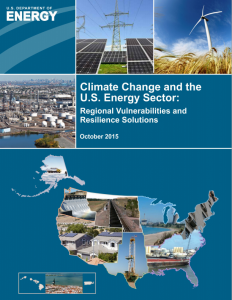Full Title: Climate Change and the U.S. Energy Sector: Regional Vulnerabilities and Resilience Solutions
Author(s): U.S. Department of Energy (DOE), Office of Energy Policy and Systems Analysis
Publisher(s): U.S. Department of Energy (DOE), Office of Energy Policy and Systems Analysis
Publication Date: October 1, 2015
Full Text: Download Resource
Description (excerpt):
Changes in climate create diverse challenges across the U.S. energy system. Some energy infrastructure assets have already suffered damage or disruption in services from a variety of climate-related impacts, such as higher temperatures, rising sea levels, and more severe weather events. In the absence of concerted action to improve resilience, energy system vulnerabilities pose a threat to America’s national security, energy security, economic wellbeing, and quality of life.
Building climate change resilience into our energy infrastructure planning is a challenging and complex undertaking. Planning horizons can span several decades (the typical service life of most energy assets), associated investments can extend into the billions of dollars, and relevant technologies can change rapidly. Some climate change impacts may trigger cascading effects on natural resources, energy demand, and supply chains. Challenges are compounded when addressing climate risks at the regional or local level, where climate change projections are subject to less certainty than at the national scale.
The U.S. Department of Energy (DOE) has proactively launched numerous initiatives to support and facilitate energy sector climate preparedness and resilience at national, regional, and local levels. In addition to enhancing resilience to climate change, these actions may also have co-benefits that accommodate non-climate resilience needs (e.g., aging infrastructure, cybersecurity, physical attacks, geomagnetic storms). To assist infrastructure owners and utility planners, DOE has compiled this report on regionspecific energy vulnerabilities to climate change (see Figure ES-1) and current resilience solutions.
